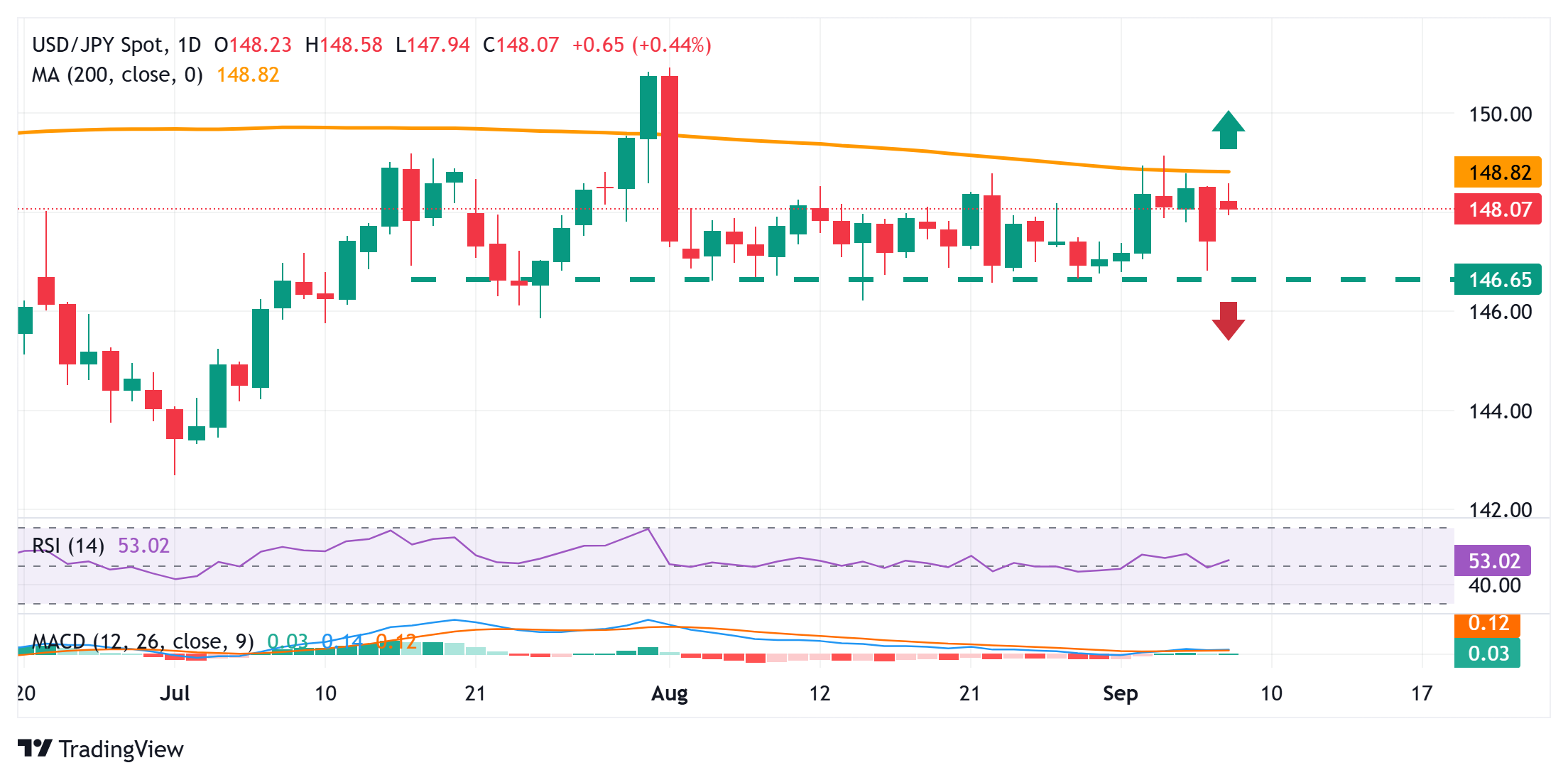Created
: 2025.09.08














![]() 2025.09.08 11:40
2025.09.08 11:40
The Japanese Yen (JPY) gaps lower at the start of a new week in reaction to news over the weekend that Japan's Prime Minister Shigeru Ishiba will step down. This overshadows the latest optimism over the recently signed US-Japan trade deal, which will entail lower trade tariffs on Japan and an upward revision of Japan's Q2 GDP growth figures. Adding to this, stronger-than-expected private spending data released on Friday could allow the Bank of Japan (BoJ) to hike interest rates in the coming months, though it does little to impress the JPY bulls.
Apart from this, the risk-on mood - as depicted by a generally positive tone around the equity markets - is seen as another factor undermining the JPY's safe-haven status. The US Dollar (USD), on the other hand, is seen moving away from its lowest level since July 28, touched in reaction to the disappointing US Nonfarm Payrolls (NFP) report on Friday, and further lends support to the USD/JPY pair. The JPY, however, manages to hold above a one-month low touched against its American counterpart last week, warranting some caution for bearish traders.

From a technical perspective, the intraday move higher stalls near the very important 200-day Simple Moving Average (SMA) barrier, currently pegged near the 148.75 region. This is closely followed by the 149.00 round figure and the 149.20 area, or a one-month high touched last week. The latter represents the 61.8% Fibonacci retracement level of the decline from the August swing high, which, if cleared decisively, would be seen as a fresh trigger for the USD/JPY bulls. Spot prices might then aim to reclaim the 150.00 psychological mark and extend the momentum further towards challenging the August monthly swing high, around the 151.00 neighborhood.
On the flip side, weakness below the 148.00 round figure could attract some dip-buyers near the 147.45-147.40 region. This should limit the downside for the USD/JPY pair near the 147.00 mark. Some follow-through selling below the 146.80-146.70 strong horizontal support would shift the near-term bias in favor of bearish traders and expose the August swing low, around the 146.20 region, before spot prices eventually drop to the 146.00 mark.
The Japanese Yen (JPY) is one of the world's most traded currencies. Its value is broadly determined by the performance of the Japanese economy, but more specifically by the Bank of Japan's policy, the differential between Japanese and US bond yields, or risk sentiment among traders, among other factors.
One of the Bank of Japan's mandates is currency control, so its moves are key for the Yen. The BoJ has directly intervened in currency markets sometimes, generally to lower the value of the Yen, although it refrains from doing it often due to political concerns of its main trading partners. The BoJ ultra-loose monetary policy between 2013 and 2024 caused the Yen to depreciate against its main currency peers due to an increasing policy divergence between the Bank of Japan and other main central banks. More recently, the gradually unwinding of this ultra-loose policy has given some support to the Yen.
Over the last decade, the BoJ's stance of sticking to ultra-loose monetary policy has led to a widening policy divergence with other central banks, particularly with the US Federal Reserve. This supported a widening of the differential between the 10-year US and Japanese bonds, which favored the US Dollar against the Japanese Yen. The BoJ decision in 2024 to gradually abandon the ultra-loose policy, coupled with interest-rate cuts in other major central banks, is narrowing this differential.
The Japanese Yen is often seen as a safe-haven investment. This means that in times of market stress, investors are more likely to put their money in the Japanese currency due to its supposed reliability and stability. Turbulent times are likely to strengthen the Yen's value against other currencies seen as more risky to invest in.
![]()
Created
: 2025.09.08
![]()
Last updated
: 2025.09.08

FXStreet is a forex information website, delivering market analysis and news articles 24/7.
It features a number of articles contributed by well-known analysts, in addition to the ones by its editorial team.
Founded in 2000 by Francesc Riverola, a Spanish economist, it has grown to become a world-renowned information website.
We hope you find this article useful. Any comments or suggestions will be greatly appreciated.
We are also looking for writers with extensive experience in forex and crypto to join us.
please contact us at [email protected].
Disclaimer:
All information and content provided on this website is provided for informational purposes only and is not intended to solicit any investment. Although all efforts are made in order to ensure that the information is correct, no guarantee is provided for the accuracy of any content on this website. Any decision made shall be the responsibility of the investor and Myforex does not take any responsibility whatsoever regarding the use of any information provided herein.
The content provided on this website belongs to Myforex and, where stated, the relevant licensors. All rights are reserved by Myforex and the relevant licensors, and no content of this website, whether in full or in part, shall be copied or displayed elsewhere without the explicit written permission of the relevant copyright holder. If you wish to use any part of the content provided on this website, please ensure that you contact Myforex.
Myforex uses cookies to improve the convenience and functionality of this website. This website may include cookies not only by us but also by third parties (advertisers, log analysts, etc.) for the purpose of tracking the activities of users. Cookie policy